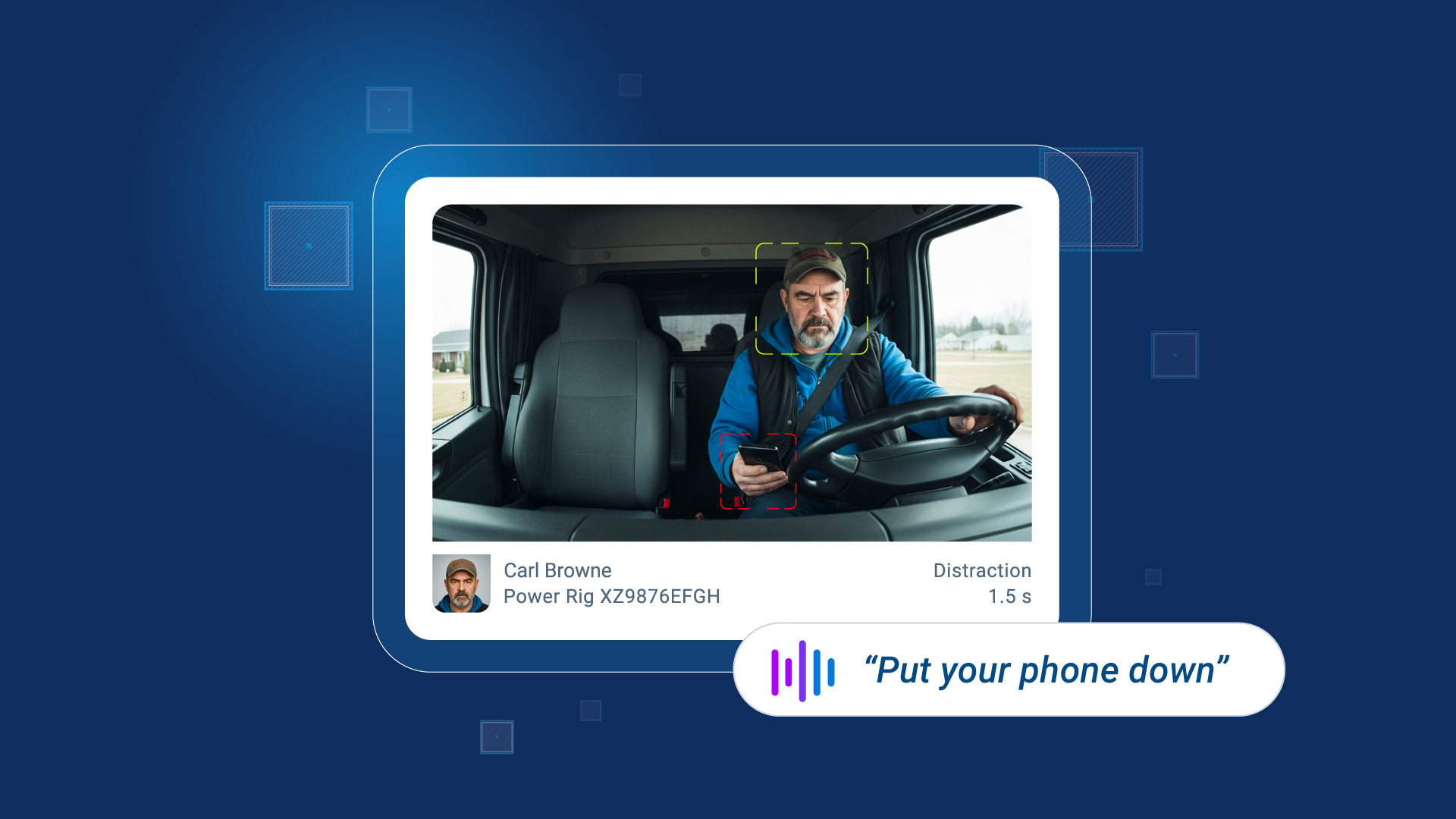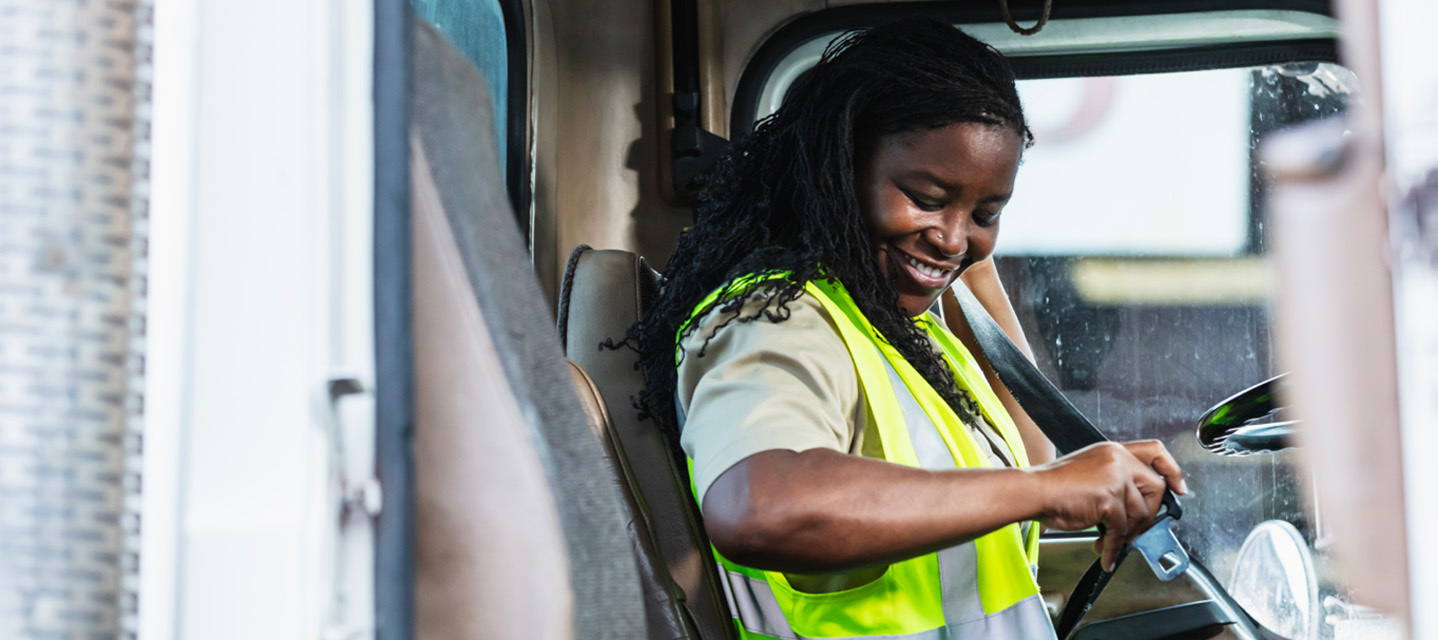How AI dash cams help fleets tackle distracted driving and reduce collisions
AI dash cams use real-time driver coaching and fleet safety technology to identify, prevent and reduce distracted driving collisions across fleets.

Content Marketing Manager • Corporate Marketing
Oct 23, 2025

Key Insights
- AI dash cams detect and alert distracted driving behaviors in real time, enabling immediate driver coaching that prevents collisions before they happen.
- By analyzing event data like phone use, fatigue, and tailgating, fleet safety technology helps managers flag and address risky habits – cutting crashes and costs.
- AI dash cam collision prevention works by surfacing urgent risks instantly for managers and giving drivers immediate feedback, leading to safer operations and reduced claims.
Distracted driving is remaking the risk map for fleet operators, sending costs, downtime and insurance claims sharply upward. Each year, rising rates of distraction take more vehicles off the road and add pressure to schedules and staff. In the U.S. alone, distracted driving contributed to over 324,000 injuries and thousands of deaths in 2023, a crisis that touches every level of a fleet’s business. Across the industry, every 10% jump in distraction means $4 billion in additional losses. In the first six months of-In the first six months of 2024, distracted driving violations grew by 48%, with record write-offs compounding the operational impact. For every vehicle out of commission, the ripple effects of missed jobs, unhappy customers and stressed drivers grow.
Most safety programs still look backward, reacting to events after they happen. AI dash cams are changing that, giving fleets the power to spot distraction as it happens, coach drivers in the moment and help prevent collisions before they happen. Prevention, instead of just proof, is within reach.
Where traditional dash cams fall short
Most dash cams sit quietly on the dash, doing one thing well: replaying the past. Managers get long hours of grainy footage showing what went wrong after the fact, but by then, the chance to stop an incident is already gone. Traditional systems don’t alert drivers in the moment or offer in-cab coaching, so risky actions, like glancing at a phone or a missed stop sign, end up buried among hours of footage.
For safety teams, this means wading through endless clips to find the needle in the haystack, hoping to catch repeat risky habits buried in routine driving. In the meantime, risky patterns continue unchecked.Evidence is easy, prevention is not and fleets pay the price in avoidable collisions, wasted hours and coaching that always comes too late.
How AI dash cams change the game
Traditional dash cams record. AI dash cams watch and intervene, and that’s the difference between replaying a collision and preventing it. In addition to recording, today’s advanced dash cams analyze, alert and act as a second set of eyes with zero lag.
Here’s how AI dash cams optimize fleet safety:
| Feature | What it does | Results |
| Detect distraction in real time | Spots phone use, fatigue, tailgating and immediately alerts the driver | Stops risky behavior before it causes a collision |
| Deliver in-cab voice coaching | Provides immediate voice feedback to drivers | Helps drivers correct unsafe actions in the moment |
| Highlight critical events | Surfaces urgent incidents for managers | Saves review time, focuses on the riskiest events |
| Activate a coaching workflow | Turns flagged events into trackable coaching sessions | Builds long-term driver improvement |
What behaviors do AI dash cams detect?
AI dash cams use onboard intelligence and video analytics to identify risky driving behaviors in real time, turning each trip into actionable data. They spot patterns such as:
- Phone use – Detects when a driver handles, glances at or interacts with a mobile device.
- Eyes off road – Flags periods when attention drifts away from driving.
- Tailgating – Measures following distance and alerts when vehicles get too close.
- Fatigue and drowsiness – Monitors for signs of micro-sleep or sustained eyelid closure.
- Eating, drinking and smoking – Identifies manual distractions that take hands off the wheel.
- Seatbelt use – Monitors whether seatbelts are fastened, supporting safety compliance.
- Rolling stops, hard braking and rapid acceleration – Captures core compliance and aggressive maneuvers, showing if an event was defensive or risky.
- Other in-cab distractions – Detects patterns of repeated reaching, adjusting music, or engaging in distracting, prolonged interaction with passengers.
By analyzing driver actions and vehicle dynamics together, AI dash cams can spot isolated distractions and dangerous patterns, giving fleets an early warning system for preventable risk.
How targeted coaching changes driver behavior
Advanced dash cams change driver coaching by quickly surfacing the most urgent risks to managers and delivering immediate in-cab voice prompts to drivers. Each event is tagged with video, speed, and location, so managers see exactly what happened, when, and who needs input.
Alerts also kick-off a focused workflow where managers assign coaching, track how drivers respond and close the feedback loop, all in one platform, building safer routines over time. Progress is visible. Repeated habits get flagged, improvements are recognized and both metrics and positive feedback are logged for every trip.
For drivers and managers this means fewer repeat offenses, faster habit changes and less wasted time sifting through irrelevant footage. Driver coaching becomes measurable, timely and positive, giving managers a direct view of risk trends and helping crews stay ahead of challenges.
The impact on collision reduction
For fleets, the math is simple: less distraction means fewer collisions, and AI dash cams are driving down incident rates where older safety measures have stalled. In pilot programs with the new Geotab GO Focus Plus AI dash cam, phone use plummeted up to 95%, helping operators cut a core cause of preventable collisions nearly overnight.
Detection accuracy is no longer a guessing game. Geotab’s GO Focus Plus AI dash cams flag risky habits like distraction, tailgating and fatigue with more than 99.9% precision, so safety teams focus coaching exactly where it’s needed.
But the numbers only tell half the story. Fleets that deploy advanced dash cams see ripple effects throughout the organization and on the bottom line. Insurance experts and industry groups report that advanced dash cams, coupled with data-driven coaching, not only reduces incident rates but also strengthens claims and can lower premiums for responsible fleets.
Bringing focus and control back to your fleet
Switching to AI dash cams turns safety from an administrative burden to a working process that keeps drivers alert and vehicles moving with fewer incidents. The changes show up quickly where driver habits improve, incident numbers fall and managers spend less time chasing down problems. It’s a practical change you can measure on the road and on the balance sheet.
Key takeaways for fleets:
- Real-time alerts help drivers stay focused and avoid incidents before they escalate.
- Data-driven reporting shows risky trends, so managers can target coaching where it has the most impact.
- Proactive coaching, enabled by instant driver feedback, reduces repeat issues and builds lasting safe habits.
See how real-time AI dash cams help fleets address distractions before they lead to costly incidents.
Subscribe to get industry tips and insights
Frequently Asked Questions
AI in fleet management improves safety and efficiency by using vehicle and driver data. It supports route optimization, predictive maintenance, real-time driver coaching and collision prevention. These applications help fleets reduce costs, prevent incidents and improve daily operations.
An AI dash cam is a smart in-cab camera that uses artificial intelligence to detect distraction and risky behaviors in real time. It gives instant driver alerts and coaching, while helping managers reduce collisions and claims.
Fleet AI refers to the use of artificial intelligence across fleet operations. Examples include AI dash cams, predictive maintenance, route planning and driver behavior analysis. These tools improve safety, cut costs and enhance performance across fleets.

Content Marketing Manager • Corporate Marketing
.
Table of Contents
Subscribe to get industry tips and insights
Related posts

Collision avoidance systems: How fleets prevent incidents and improve safety
December 23, 2025
5 minute read
.png)
From the North Pole to the Highway: How AI and Predictive Insights Get Drivers Home for the Holidays
December 16, 2025
2 minute read
.jpg)
.png)
AI dash cams vs. traditional: Which delivers better fleet safety?
December 8, 2025
5 minute read


Elevating Worker Safety Through Simplicity: The OK Alone Story
December 3, 2025
2 minute read